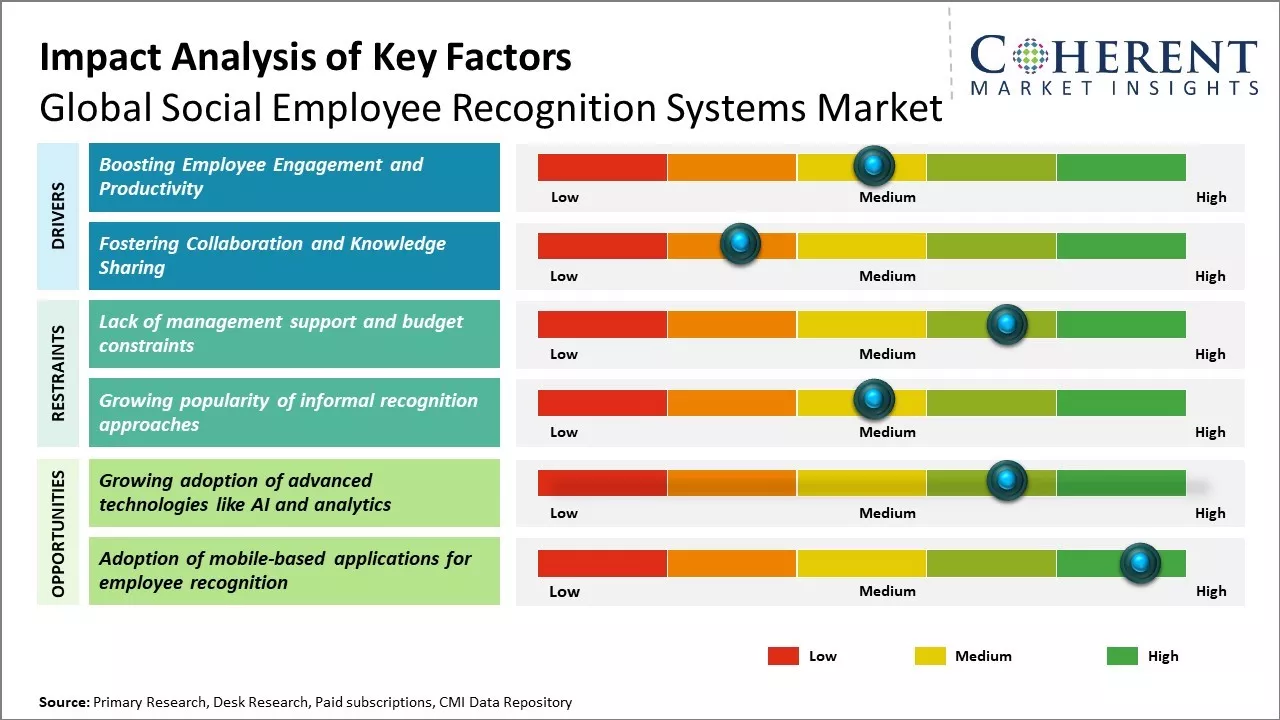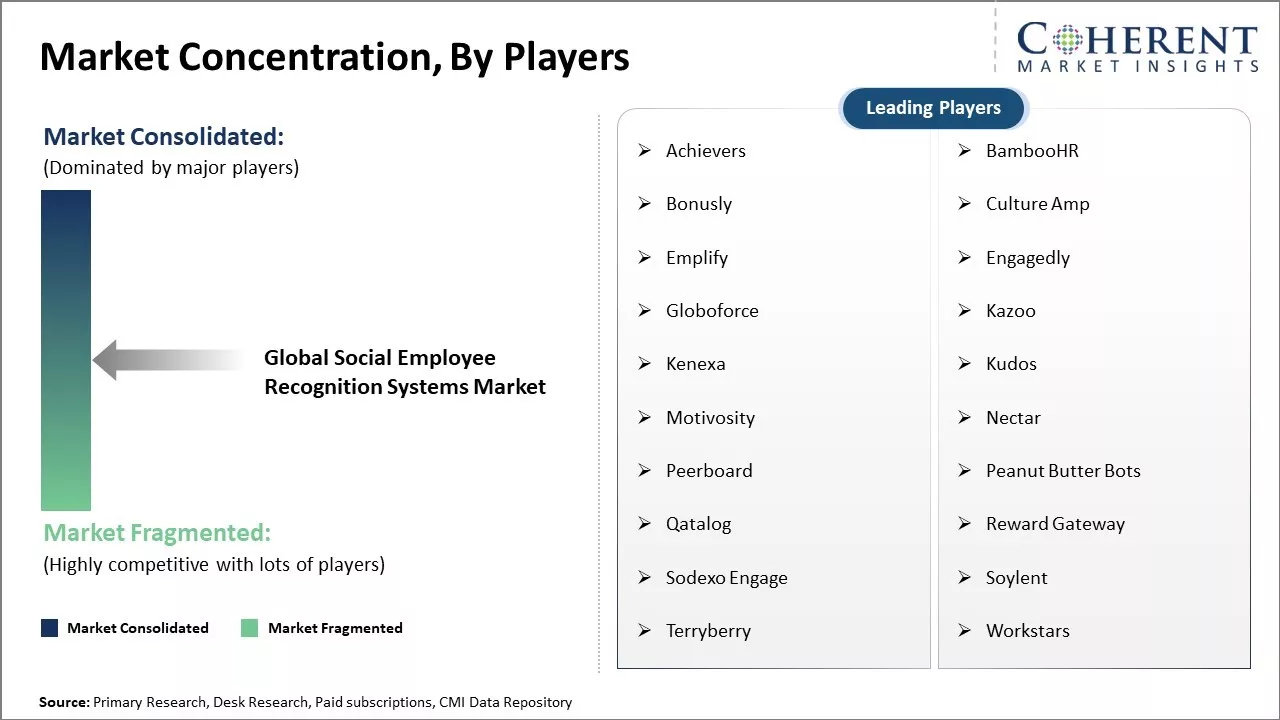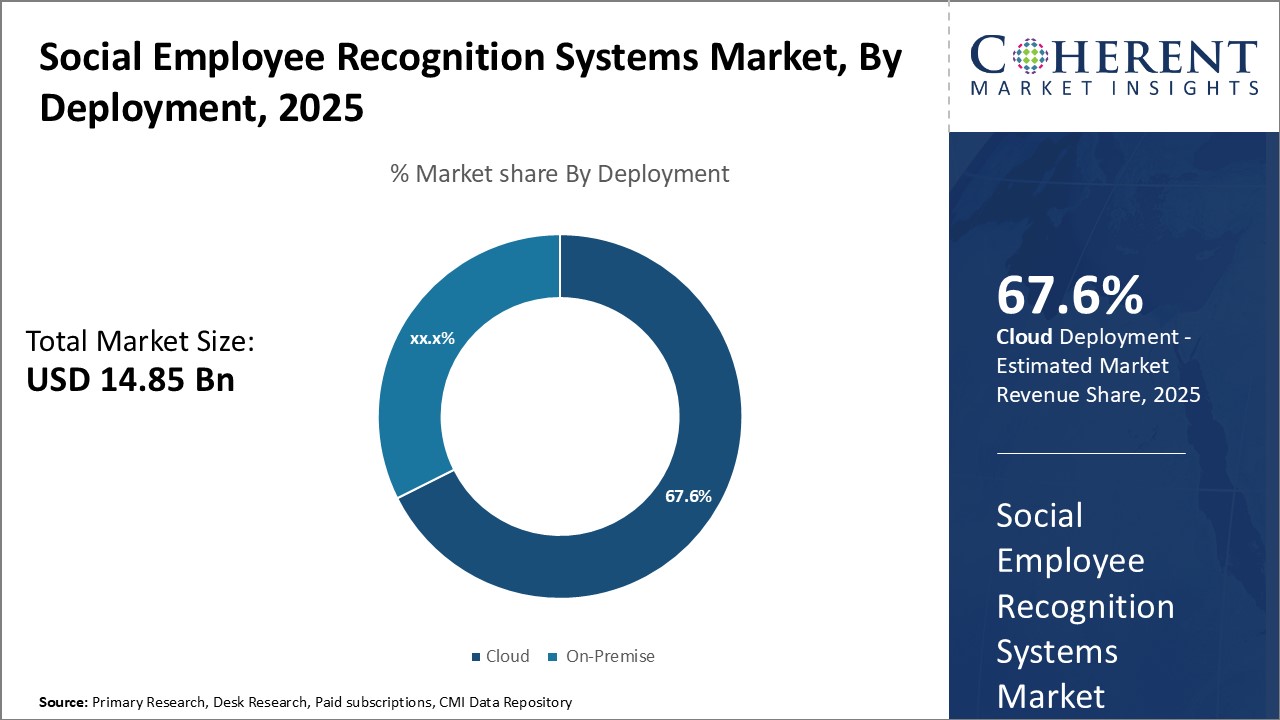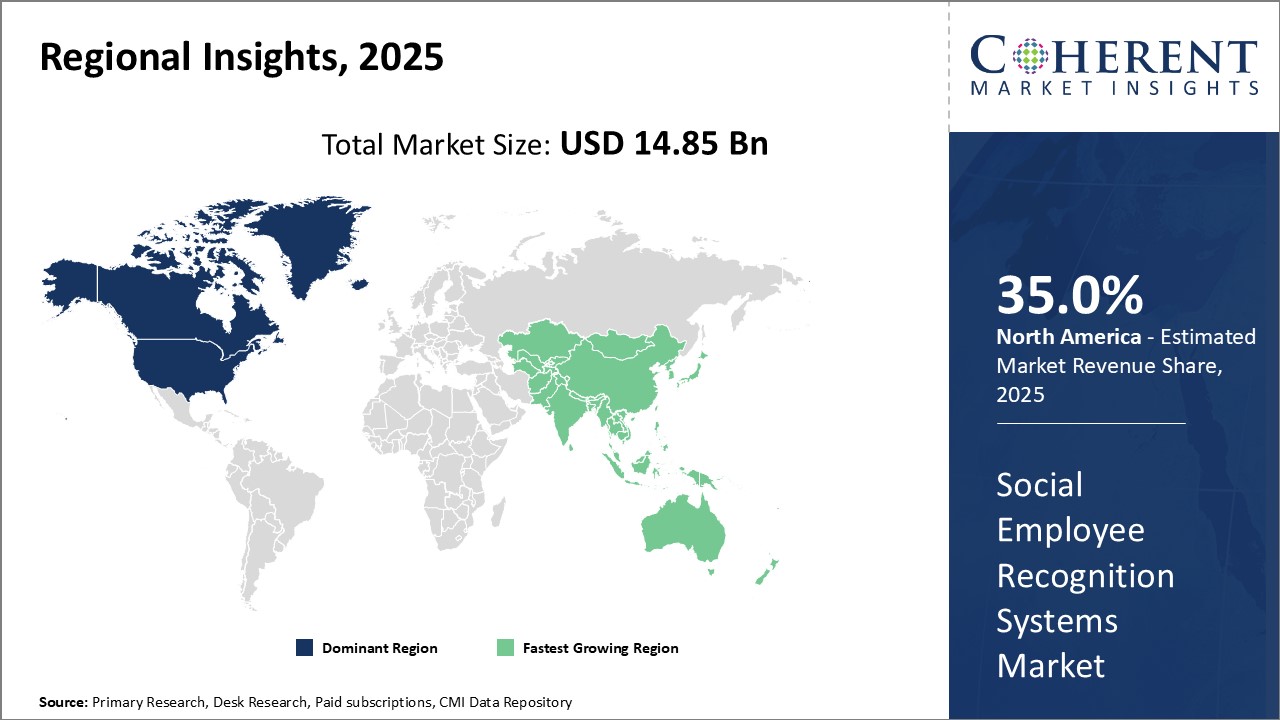The global social employee recognition systems market is estimated to be valued at US$ 14.85 bn in 2025 and is expected to reach US$ 32.65 bn by 2032, exhibiting a compound annual growth rate (CAGR) of 11.9% from 2025 to 2032.

Discover market dynamics shaping the industry: Download Free Sample
Employees today expect personalized feedback and recognition for their work more than ever before. With the rising adoption of social employee recognition platforms, companies are able to automate recognition programs and empower managers to recognize colleagues publicly as well as in private. This has boosted employee engagement and satisfaction levels globally. Additionally, the ability to recognize peers through social features is driving higher adoption amongst the younger workforce. Predictive analytics on these platforms also helps companies understand recognition trends, design data-driven recognition strategies, and link it to various HR-related metrics like performance, retention and productivity. This is expected to drive continued demand for social employee recognition systems amongst large enterprises as well as small and medium businesses over the forecast period.
Boosting Employee Engagement and Productivity
One of the major drivers for the growing adoption of social employee recognition systems by organizations is to boost employee engagement and productivity levels. Recognition and appreciation of employees' work and contributions is known to have a strong positive impact on how engaged and motivated the employees feel about their job. With social recognition systems, peers and managers can instantly recognize and applaud an employee's achievement or excellence publicly which stimulates a feel-good factor. Seeing their name and work highlighted in this manner in front of others in the organization acts as a great morale booster.
Social recognition also fosters healthy competition among employees as they try to outperform each other to earn more kudos and likes. Knowing that their superior work will be lauded by the whole organization propels employees to put in extra effort. Many organizations have reported significant increases in employee productivity metrics after implementing social recognition portals. Employees feel more accountable for delivering results as they know their work is being tracked. The public and frequent recognition satisfies an innate human need for appreciation and influences positive behavior change. It develops a culture where employees support and motivate each other. The visibility and peer approval also help retain top talent in the organization who value working in an environment where their work is valued.
At the 2021 Achievers Customer Experience (ACE) conference, Achievers, a prominent provider of employee engagement and recognition solutions, introduced the Achievers Employee Experience Platform, a comprehensive ecosystem of products and integrations designed to help organizations create a dynamic and personalized employee experience strategy that caters to the diverse needs of the modern workforce.

Get actionable strategies to beat competition: Download Free Sample
Fostering Collaboration and Knowledge Sharing
Another key driver for the growth of social employee recognition systems is their ability to foster greater collaboration and knowledge sharing among employees. With these platforms, employees can recognize and appreciate their peers for helping with a project or for sharing their expertise. Such acknowledgment nurtures positive inter-personal relationships and cross-functional cooperation. It demonstrates that the organization values teamwork and collective problem solving over working in silos.
Employees are encouraged to build their professional networks and learn from each other. They are more willing to take on stretch assignments requiring partnership with others when there is a transparent system to recognize joint efforts. Managers can highlight examples of collaboration to reinforce such behaviors organization-wide. Knowledge assets get greater exposure and reuse when people are commended for documenting and disseminating their learnings. Over time, the system strengthens collaborative habits and a culture of learning in the organization. It facilitates informal and social learning, preparing employees for variable job demands. The informed and connected workforce can quickly respond to new market conditions.
Key Takeaways from Analyst:
The global social employee recognition systems market is poised to grow significantly over the next few years. One of the key drivers for this growth is the increasing preference of employees for recognition that is public and social in nature. More employees today want their peers and colleagues to acknowledge their work and contributions. Social recognition helps satisfy this need. Another major factor fueling adoption is the ability of these systems to strengthen employee engagement and motivation. Publicly recognizing employees for their achievements significantly boosts engagement levels. However, data privacy and security concerns continue to restrain the market to some extent. Many organizations hesitate to implement social recognition fearing exposure of private employee data. However, vendors are constantly enhancing the security of their platforms to address these issues.
North America currently dominates the market due to high employee turnover rates and engagement challenges faced by organizations in the region. However, Asia Pacific is expected to emerge as the fastest growing regional market. The large young workforce and increasing focus on employee experience programs are driving adoption. Overall, the market is likely to witness steady growth in matured markets like the U.S. and Western Europe as more organizations adopt holistic employee engagement strategies. Social recognition will continue to be a vital component of these strategies. While data security challenges persist, leading vendors are striving to offer platforms that empower organizations to recognize employees socially while maintaining privacy.
Market Challenges: Lack of management support and budget constraints
Lack of management support and budget constraints are significantly restraining the growth of the global social employee recognition systems market. When management is not supportive of incorporating such recognition programs, employees do not feel encouraged to partake in them. Management needs to champion these causes and lead by example to create a culture where employees feel valued through recognition. Without strong backing from the C-suite and other leadership, recognition initiatives often fail to gain proper traction in organizations.
The financial requirements to procure and implement appropriate recognition software and platforms also poses a notable challenge. Setting up reward schemes, purchasing gifts/merchandise for top performers, and subscribing to technology solutions comes with certain investments. Many smaller companies and those in developing economies find it difficult to dedicate funds for these 'soft' initiatives due to other budgetary priorities. The pandemic has further strained budgets of businesses globally.
Market Opportunities: Growing adoption of advanced technologies like AI and analytics
The growing adoption of advanced technologies like artificial intelligence and analytics presents a great opportunity for the global social employee recognition systems market. As AI and machine learning become more sophisticated, organizations now have the ability to gain deeper insights into employee performance, feedback, and satisfaction levels. Sentiment analysis tools powered by AI can effectively analyze the massive amounts of data generated through social recognition platforms, employee surveys and feedback forums. This enables companies to identify trends, recognize top performers and areas that need improvement at a much more granular level. AI can also automate certain recognition activities like immediately thanking or praising employees on social platforms for their achievements and contributions, which helps boost engagement and motivation.

Discover high revenue pocket segments and roadmap to it: Download Free Sample
In terms of By Deployment, Cloud segment dominates the market owing to Reliability and cost-effectiveness
In terms of deployment, cloud is expected to contribute the highest share of 67.6% for 2025 in the global social employee recognition systems market owing to its agility and cost benefits compared to on-premise systems. Cloud deployments allow organizations to quickly implement recognition programs without extensive upfront infrastructure investments or long implementation timelines. This flexibility and speed of deployment are crucial to engaging modern workforces accustomed to consumer-style experiences. Cloud systems also eliminate the costs of procuring, maintaining, and upgrading on-site hardware and software over time. With pay-as-you-go pricing models, organizations can more accurately align recognition spending with operational needs and budgets. This helps avoid underutilized on-premise systems or costly upgrades. The cloud model also makes it easy for organizations to scale recognition programs globally as they grow without complex migrations or new infrastructure projects. System access from any internet-connected device further enhances the mobility and flexibility of cloud deployments compared to traditional on-site solutions. With these compelling agility and economic advantages, cloud will continue dominating the global social employee recognition systems market.
In terms of By Enterprise Size, SMEs segment dominates the market owing to Reliability and cost-effectiveness
In terms of enterprise size, SMEs segment is expected to contribute the highest share of 71.8% in the global social employee recognition systems market due to their need to informally engage smaller, tightly-knit workforces. Relative to large enterprises, SMEs have flatter organizational structures where employees often work more closely together and feel a stronger sense of community. With fewer hierarchical layers, grassroots engagement strategies are most impactful. Social recognition platforms allow any employee to easily acknowledge the contributions of colleagues, fostering a culture of appreciation. This word-of-mouth or bottom-up recognition model resonates strongly with SME workforces. Tight budgets at SMEs also make free or freemium social platforms more accessible than expensive enterprise solutions. Simpler, community-driven features on social platforms keep costs low without compromising functionality for smaller teams. As SMEs continue growing rapidly, their demand for affordable and participative recognition tools will further increase the market share of social platforms tailored for this segment.
In terms of By Industry, the IT & Telecom segment dominates the market owing to Reliability and cost-effectiveness
In terms of industry, the IT & telecom segment contributes the highest share of 24.8% for 2025 in the global social employee recognition systems market owing to its digital culture and workforce needs. As an industry powering today's tech-driven world, IT & telecom companies are pioneer adopters of innovative digital tools. Their workforces are highly tech-savvy early adopters comfortable with social platforms. Additionally, recognition plays a key role in attracting and retaining scarce talent in competitive IT job markets. Social platforms support IT/telecom's culture of frequent feedback, knowledge sharing, and informal connection among dispersed teams often working remotely or globally. Real-time recognition on these platforms boosts transparency, engagement, and camaraderie crucial for innovation. With recognition baked into routine work tools, IT employees experience appreciation as a natural part of their digital workflows. Network effects multiply as recognized work gains higher visibility, attracting even more acknowledgements. As digital transformation accelerates across industries, social recognition will grow in strategic importance for the tech-leading IT & telecom sector to evolve their talent practices.

Need a Different Region or Segment? Download Free Sample
North America has emerged as the dominant regional market with the market share of 35.0% in 2025 for social employee recognition systems. This is mainly due to the early adoption of newer technologies amongst organizations across various industries in the U.S. and Canada. Also, the presence of many innovation-driven companies as well as availability of technical expertise has created conducive environment for the growth of social recognition platforms in the region. Several top players offering these systems have their regional headquarters located in North America, allowing them to closely work with clients and understand their evolving needs.
Moreover, the workforce demographics in North America comprising of a large percentage of millennials and Gen Z have also contributed to the widespread popularity of social rewards and engagement programs. Recognition through social channels acts as a strong retention tool for companies operating in this highly competitive labor market. Enterprises are leveraging social recognition as part of their employee experience strategy to cultivate an engaged and productive environment.
The Asia Pacific region has emerged as one of the fastest growing regional markets for social employee recognition systems. The continuously expanding workforce, growing international presence of Asian companies as well as rising emphasis on employee engagement are some of the primary factors attributing to the swift growth of this market.
Countries like India, China, and Japan have a mix of small, medium as well as large enterprises operating across different industry verticals. This diverse industrial presence has augmented the demand for cost-effective social rewards platforms in Asia Pacific. Additionally, the increased adoption of bring your own device (BYOD) trend and availability of high-speed internet have positively impacted the adoption of these cloud-based solutions. Local vendors are also partnering with global social recognition software providers to address the cultural nuances and preferences of the regional workforce.
Social Employee Recognition Systems Market Report Coverage
| Report Coverage | Details | ||
|---|---|---|---|
| Base Year: | 2024 | Market Size in 2025: | USD 14.85 Bn |
| Historical Data for: | 2020 To 2024 | Forecast Period: | 2025 To 2032 |
| Forecast Period 2025 to 2032 CAGR: | 11.9% | 2032 Value Projection: | USD 32.65 Bn |
| Geographies covered: |
|
||
| Segments covered: |
|
||
| Companies covered: |
Achievers, BambooHR, Bonusly, Culture Amp, Emplify, Engagedly, Globoforce, Kazoo, Kenexa, Kudos, Motivosity, Nectar, Peerboard, Peanut Butter Bots, Qatalog, Reward Gateway, Sodexo Engage, Soylent, Terryberry, and Workstars |
||
| Growth Drivers: |
|
||
| Restraints & Challenges: |
|
||
Uncover macros and micros vetted on 75+ parameters: Get instant access to report
*Definition: Social employee recognition systems are digital tools that allow employers to publicly recognize employees for work achievements, milestones or good behaviors. These systems enable companies to highlight top performers through social shares, newsfeeds, likes and comments visible to all employees. They aim to foster employee engagement and motivation by cultivating a culture of peer recognition, feedback and appreciation through social recognition platforms integrated with workplace communication channels and employee profiles. Recognition can be around work anniversaries, sales success, innovation, customer service and more.
Share
Share
About Author
Monica Shevgan has 9+ years of experience in market research and business consulting driving client-centric product delivery of the Information and Communication Technology (ICT) team, enhancing client experiences, and shaping business strategy for optimal outcomes. Passionate about client success.
Missing comfort of reading report in your local language? Find your preferred language :
Transform your Strategy with Exclusive Trending Reports :
Frequently Asked Questions
Joining thousands of companies around the world committed to making the Excellent Business Solutions.
View All Our Clients